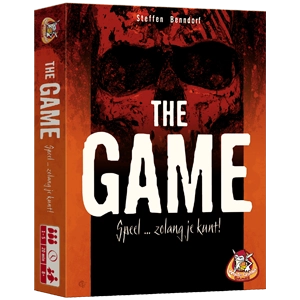The Game, play … while you can!
During the game, four piles of cards form in the center of the table. Two stacks increase in value (1-99), and two stacks decrease in value (100-2). Players play together against the game and try to discard as many cards, at best all 98, on the four stacks.
Playing cards
In an ascending pile, the cards played must be higher and higher in value. The jumps between consecutive cards may be as large or small as you wish. For example, 3, 11, 12, 13, 18, 20, 34, 35, 51. Or 2, 7,19,25,28,29,49, etc. Try to keep the jumps as small as possible so that more cards can be played.
Important: For clarity, the cards are not placed on the starting card, but in a pile next to it. Thus, during the game a pile is formed next to each starting card of which only the top card is always visible.
With a stape falling in value, it is just the opposite. Thus, the cards played must be lower and lower in value. For example, 94, 90, 78,61,§à,57. Or 98, 97, 88, 83, 81, etc.
Preparation for the game
Place the four starting cards under each other in the center of the table. Shuffle the 98 playing cards. In a 3-, 4- or 5-player game, each player is dealt 6 cards. In a 2-player game, both players receive 7 cards. If you play alone, you get 8 cards. Cards are taken in hand. Place the remaining playing cards in a covered draw pile to the left of the starting cards.
Game play
After all players have looked at their cards, determine the starting player. Starting from the starting player, play is clockwise. The player whose turn it is must play at least two cards from their hand. He plays these cards on a deck of his choice, right from the starting cards. A player may play more than two cards; he may even play all of his cards. The cards are played one at a time. The player always decides which pile to play a card on (according to the rules for playing cards). The player can play all cards on the same pile, or optionally on different piles.
Example: Arno’s turn. He plays a card on the top ascending pile, then two cards on the other ascending pile, and finally a card on the bottom descending pile.
At the end of his turn, the player draws cards from the draw pile until he again has exactly 6 cards (in case of three, four or five players), 7 cards (in case of two players) or 8 cards (if you are playing alone) in his hand. Then it is the next player’s turn.
Example: After Arno plays four cards, he ends his turn by drawing four cards from the draw pile and taking them into his hand.
The reverse trick!
During the game, the four stacks inevitably grow larger as more and more cards are placed on them. The previously described rules for playing cards remain in effect, with one exception: the player whose turn it is has the option of playing“backwards” and with exactly the value of 10. This goes as follows:
- On a rising pile, a player, whose turn it is, may place a card exactly 10 lower in value.
Example: Normally, a card higher than 47 must be played on this rising pile. Mike’s turn. He has the 37 in his hand and may play this card on the pile because the card is exactly lower in value. - On a decreasing pile, a player, whose turn it is, may place a card that is exactly 10 higher in value.
Example: Normally, on this descending stack, a card must be played that is lower than 65. Julia’s turn. She has the 75 in her hand and may play this card on the pile because the card is exactly 10 higher in value.
Note: A player may use the reverse trick multiple times during his turn, even on different stacks. For example, a player might first play a card the normal way, then apply the backward trick, then play two cards again the normal way, then apply the backward trick again, then play another card the normal way, and so on.
What can be discussed
During the game, players should never ask for the exact values of the playing cards or reveal their own cards. Calling the values in your hand is strictly forbidden! Beyond that, all communication is allowed, such as, for example, “please do not play on the bottom stack” or “on this stack only make a small jump.”
End of the game
When the draw pile is depleted, play continues with no new cards to be drawn. Important: From then on, players need only play one card (or several if they wish) during their turn. Then, when a player has played his last card, the other players play on without him (he is skipped if it would be his turn). The game ends immediately if, at the beginning of his turn, a player can no longer play the prescribed minimum number of cards while he still has cards in hand (i.e., two cards if there are still cards in the draw pile or one card, if it runs out) or if all cards have been played.
How good were the players? When the game ends, the total number of cards not played is counted, that is, all players’ remaining hand cards plus any remaining cards in the draw pile. A result below 10 is fantastic. Once all 98 playing cards are in, you master the basic game – and can make it more difficult the next few times with the expert rules.
For experts
All the rules described apply in this variant. Only now each player must play 3 (instead of 2) cards per turn. To make the game even more challenging, the number of hand cards can also be reduced by 1. So with three, four or five players only 5, with two players to 6 and if you play alone to 7.
Game design: Steffen Benndorf
Graphic design: Oliver and Sandra Freudenreich
Dutch translation: Jeroen van der Valk
Final editing: Jeroen Hollander

